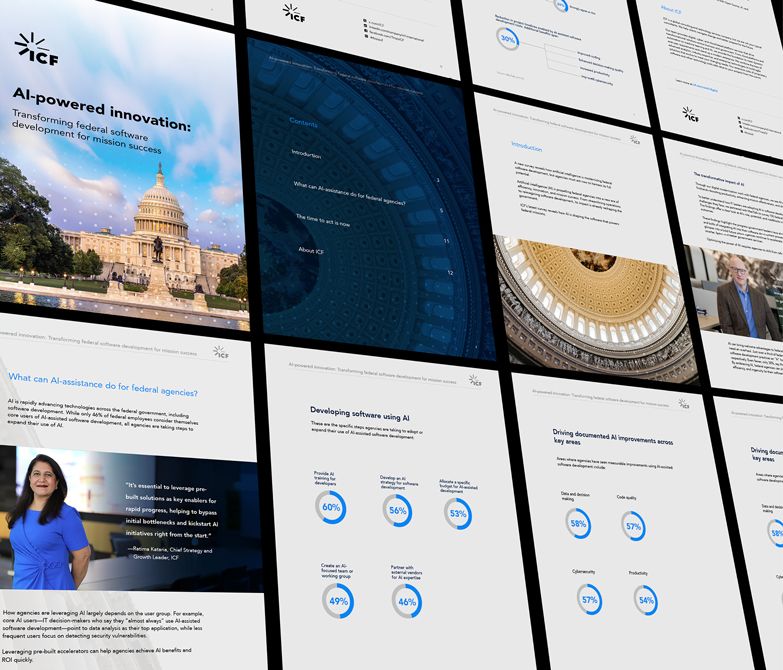
How to embed AI into agency workflows—without disruption
A practical, cost-effective path to faster, more informed decision-making
In the evolving public sector landscape, federal agencies are under increasing pressure to deliver timely, high-impact results with fewer resources. Expectations around agility, precision, and responsiveness continue to grow. Yet many agencies still face operational friction from siloed systems, fragmented data, complex analysis and decision-making, and manual processes—especially in moments where speed and clarity are most essential.
While artificial intelligence is often seen as the solution, much of the public discourse around AI centers on highly interactive tools like chatbots or copilots. However, the real operational value often lies in the less visible but more impactful work of intelligent automation embedded within agency workflows.
AI implementations can be complex, resource-intensive, and disruptive to daily operations. A more measured and pragmatic approach—what we refer to as “embedded AI”—offers a path forward. Embedded AI refers to the seamless integration of AI-driven insights and actions into existing systems by interfacing AI agents through APIs with targeted prompts, minimizing disruption while enhancing capability. This approach allows agencies to incorporate AI capabilities directly into existing workflows, augmenting human decision-making without overhauling trusted systems or retraining personnel.
For example, ICF developed an embedded AI solution that automates the monitoring of resilience funding opportunities for state and local governments. By integrating generative AI into existing workflows, the system scans multiple sources in real time, extracts key details, and alerts relevant teams—streamlining a previously manual, time-consuming process.
This form of AI operates quietly behind the scenes, supporting staff. It enables more efficient processes by automating repetitive tasks, identifying patterns in real time, and generating insights where they’re needed most. Because it integrates with familiar systems, it reduces friction and promotes higher adoption across teams.
The easiest AI to adopt is the kind that meets users where they already are. By integrating into existing legacy systems and workflows, AI reduces the need for major change management—letting teams work as they always have, just smarter.
Consider the enhancements to routine operational challenges: parsing webpage form data by pasting a raw email into an application, getting quick summaries of attachments, or receiving automatic recommendations on possible courses of action. Embedded AI handles these functions automatically, within the systems teams already use. There’s no need to introduce new platforms or disrupt day-to-day responsibilities. The result is immediate, system-wide visibility into key metrics—performance, resource allocation, outcomes—delivered through a unified, accessible interface.
Evolving intelligence: The path from legacy to AI-driven systems


Why embedded AI wins over stakeholders
Beyond reporting, embedded AI supports more agile decision-making. It enables faster course corrections, more effective resource alignment, and greater confidence in responding to change.
For example, embedded AI can distill large volumes of text into actionable summaries, surface potential risks in near real time, streamline internal approvals, and anticipate process bottlenecks—all without adding new layers of complexity. It’s designed to enhance the capabilities of teams, not complicate their work.
Adoption is also easier because it meets users where they are: in the legacy systems. Change management is often one of the biggest challenges in government technology initiatives. But when AI is integrated into existing workflows and tools, the need for major training, process redesign, or user buy-in is significantly reduced. Teams continue to work as they always have—just more efficiently and with greater insight.
This approach also strengthens data security by ensuring information remains within familiar, governed systems. And embedded AI empowers you to be nimble and add small, incremental AI features without trying to boil the ocean with an all-encompassing chatbot or entirely new systems and interfaces. You retain the freedom and speed to think small—making it a strong fit for agencies operating under tight timelines and budget constraints.
Ultimately, embedded AI isn’t just a technological upgrade, it’s a strategic capability. When thoughtfully deployed, it helps federal leaders accelerate performance, strengthen mission delivery, and operate with greater clarity and confidence in a fast-changing environment.
